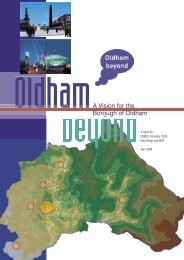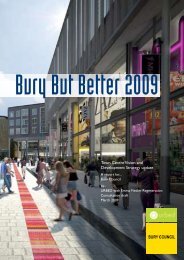Discovering Accrington - Urbed
Discovering Accrington - Urbed
Discovering Accrington - Urbed
You also want an ePaper? Increase the reach of your titles
YUMPU automatically turns print PDFs into web optimized ePapers that Google loves.
Townscape Quality<br />
Materials<br />
Buildings within the town centre were reviewed to<br />
assess their contribution to townscape quality. New<br />
development constructed with little regard to the<br />
scale, massing or form of existing buildings can<br />
have a significant impact on the visual and physical<br />
character of the area. In general there exists a strong<br />
townscape around Blackburn Road, Church Street,<br />
Warner Street and Cannon Street areas. Weaker areas<br />
of townscape are largely confined to the periphery of<br />
the town centre.<br />
However a number of buildings within and immediately<br />
adjacent to the <strong>Accrington</strong> Town Centre Conservation<br />
Area do not possess sufficient architectural detailing/<br />
interest to be regarded as making a positive<br />
contribution to the character of the area.<br />
For example, although located beyond the boundary,<br />
the Telephone Exchange between Bank, Bridge and<br />
Infant streets is highly visible from the northern part<br />
of the conservation area and does little to enhance<br />
its character.<br />
Constructed during the 1970s this three storey<br />
building, characterised by an unsympathetic concrete<br />
tiled and yellow façade, is located immediately<br />
adjacent to 32 Blackburn Road and within close<br />
proximity to the town’s grade II listed Market Hall, both<br />
of which are considered to be of some architectural<br />
merit.<br />
However, the Telephone Exchange appears to<br />
have been constructed within little or no regard to<br />
its historic or architectural context and as such is<br />
considered to have a serious negative impact upon<br />
the visual quality of the Blackburn Road/Peel Street/<br />
Church Street junction. Again located beyond the<br />
boundary, 2 – 16 Broadway also adversely affects<br />
the visual quality and character of <strong>Accrington</strong> Town<br />
Centre Conservation Area.<br />
Constructed as an extension to the Town Hall during<br />
the 1960s, this three storey building is characterised<br />
by alternant white and blue horizontal banding. Whilst<br />
the juxtaposition of old and new can sometimes be<br />
positive, in this case the extension was seemingly<br />
constructed with little regard to the scale, massing or<br />
form of the grade II* building to which it is attached.<br />
The former Barnes furniture store, located at the<br />
junction of Church Street and Cannon Street<br />
immediately beyond the southern boundary, is<br />
considered to undermine the visual quality of this<br />
part of the conservation area. Constructed during the<br />
late twentieth century, again with seemingly little or<br />
no regard to its historic or architectural context, this<br />
building dominates the view of Church of St James’<br />
from Grange Lane.<br />
Although <strong>Accrington</strong> is famed for the production<br />
of dense red bricks known as ‘<strong>Accrington</strong> Bloods’,<br />
the town is notable for its relative lack of brickbuilt<br />
structures. The majority of buildings within the<br />
conservation area were traditionally constructed<br />
from locally quarried Carboniferous gritstone, a<br />
sedimentary rock that is composed of coarse sand<br />
grains with inclusions of small stones.<br />
The finish of gritstone varies with building function:<br />
public, civic and ecclesiastical buildings were<br />
typically constructed of ashlared masonry, whilst<br />
residential buildings were constructed using roughly<br />
hewn blocks.<br />
A notable exception within the conservation area<br />
is the Warner Street entrance to the Arcade which<br />
was built in 1880 of red brick with white terracotta<br />
dressings, whilst beyond the boundary the Post<br />
Office on Abbey Street is constructed of red brick<br />
and detailed in sandstone.<br />
Despite more than a century of industrial pollution<br />
the conservation area show remarkably little sign of<br />
erosion. Indeed it was the gritstone’s hard-wearing<br />
nature, its abundance and its versatility that originally<br />
made it the preferred choice for building construction<br />
within the town. Roofs within the town were, at least<br />
traditionally, covered in gritstone slabs; however the<br />
majority of buildings within the conservation are a<br />
are roofed in blue-grey Welsh slate or lighter and less<br />
expensive substitutes.<br />
42



